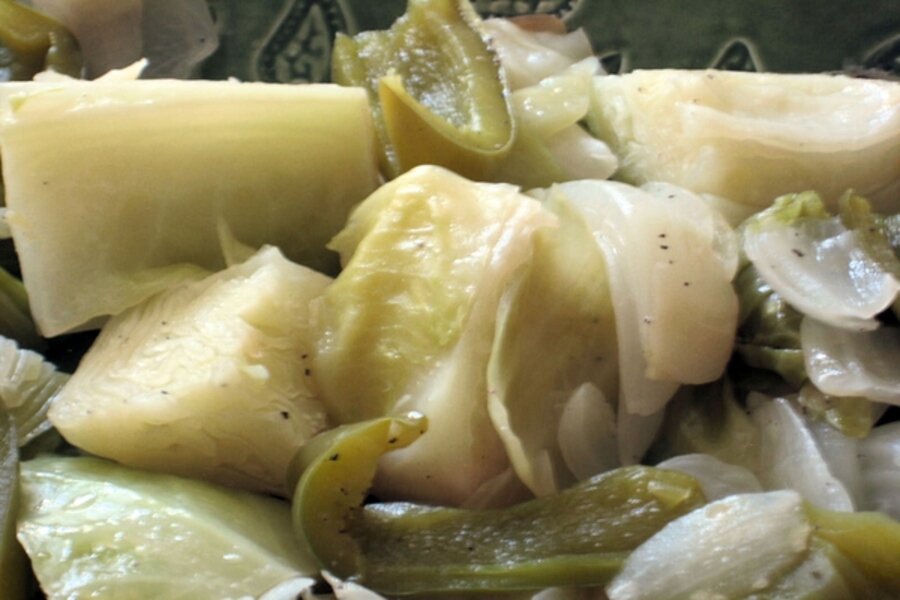How to grow and prepare cabbage
Loading...
Cabbage, because it grows best in cool weather, is one of those vegetables that will withstand frosts, says Anne, the gardener. You can put cabbage plants out in the garden in late summer or early fall. Depending on the variety, these plants should have cabbage heads to harvest in about two months.
To determine the exact time to plant, count backwards from your expected first frost, and then add a couple of weeks if you are not in a heavy freeze zone. This will tell you when you should plant cabbage in the garden.
The plants should be spaced about 15 inches apart. They should go in the ground no deeper than they are growing in their seedling pot.
Avoiding insects
In the spring, wrap the stem of each plant with a strip of newspaper extending it above and below ground. This will help to keep cutworms from finding and boring into the stems. These are not much of a problem on fall grown cabbage.
The best way to combat cabbageworms is to cover your plants with a floating row cover as soon as you have planted. This keeps the cabbage moth from laying her eggs on your plants. No eggs, no caterpillars/worms.
Make sure you fertilize with a good dose of nitrogen. Green vegetables need nitrogen to produce their leaves. If the fall rains are sparse, add water to keep the soil moist. Covering the ground with mulch will also keep the roots cool and moisture in the soil.
Harvest when the heads are firm when you squeeze them. (If they feel airy, they are not ready.) Cut them off at the soil level and try your fresh cabbage with chef Linda’s easy recipe, which follows.
Bibba’s steamed cabbage by way of Japan
Bibba and I (Linda) were in the kitchen, and she motioned for me to come over toward the stove as she said, “Come here and let me show you what that girl from Japan taught me to cook," referring to the foreign exchange student visiting our house.
So I peeked into the pot as Bibba raised the lid, and there was a steamed cabbage with onion wedges, bell pepper wedges, and sticks of celery. At the bottom of the pot, I could see a small amount of water with the butter pooled on top of it.
While I was looking, I was thinking, "Hmmm, this is not our usual Southern cabbage," but it looked so good. So I said, "Bibba, let’s taste it," and that we did.
It was delicious. Tender yet crisp wedges of green cabbage, onions, peppers, and celery steamed with butter made a sweet mélange of vegetables with each of the other vegetables marrying into the cabbage.
I guess they don’t call it a mélange of vegetables in Japan. But that exchange student sure did teach Bibba the cook how to make really good steamed cabbage. Bibba taught me how to make the cabbage in 1964, and that cabbage recipe is still one that I make today.
It’s the simplest and easiest of my recipes for vegetables. Oh, it’s so good.
Cabbage With Bell Pepper, Celery, and Onion
1 medium cabbage (about 2 pounds)
2 stalks celery, cut in half
1 large green bell pepper, cut into 6 wedges
1 large (10-to-12-ounce) onion, cut into 6 wedges
2 tablespoons cold water
2 tablespoons butter, plus more for serving
Salt and pepper to taste
Cut the cabbage into quarters. Cut the quarters in half horizontally. Place the cabbage into the bottom of a Dutch oven large enough for all the cabbage to fit on the bottom. Add the celery, bell pepper, and onion. Salt and pepper the top. Add 2 tablespoons cold water and 2 tablespoons butter.
Cover tightly, place on medium high heat (on my gas stove, a 4), and cook until cabbage is tender, about 25 to 28 minutes. Check cabbage for desired tenderness before removing to a plate or platter.
Remove the vegetables to a platter and dot the top with more butter plus salt and pepper to taste. Serve hot. Makes 4 to 6 servings.
Editor's Note: To read more of Anne and Linda's "how to grow and prepare" series, click here.
-----
Linda Weiss and Anne Moore met while Linda was the food editor and Anne was the garden editor for South Carolina Homes & Gardens magazine. They now write articles for the ETV GardenSMART television show website, where Anne is the horticulture editor, gardening consultant, and e-newsletter editor. Anne has written for magazines and newspapers. She is a member of and a recipient of a Silver Award for magazine writing from the Garden Writers Association. Linda is a personal chef. She attended Le Cordon Bleu of Paris’ catering program, has appeared as a guest chef on numerous television shows, has been a culinary educator for 10 years, and a food writer for a number of magazines. She is a professional member of The James Beard Foundation and the Southern Foodways Alliance. She has written a cookbook, "Memories From Home, Cooking With Family and Friends."





